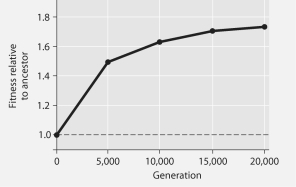The following questions refer to Figure 27.1 below, which is the same as Figure 27.10 in the textbook.
In this 8-year experiment, 12 populations of E. coli, each begun from a single cell, were grown in low-glucose conditions for 20,000 generations. Each culture was introduced to fresh growth medium every 24 hours. Occasionally, samples were removed from the populations, and their fitness in low-glucose conditions was tested against that of members sampled from the ancestral (common ancestor) E. coli population.

Figure 27.1
-If the experimental population of E. coli lacks an F factor or F plasmid, and if bacteriophage are excluded from the bacterial cultures, then which of these is a means by which beneficial mutations might be transmitted horizontally to other E. coli cells?
A) via sex pili
B) via transduction
C) via conjugation
D) via transformation
E) both A and C above
Correct Answer:
Verified
Q22: The following questions refer to Figure 27.1
Q23: The following questions refer to Figure 27.1
Q24: Which of these statements about prokaryotes is
Q25: Figure 27.2 depicts changes to the amount
Q26: The following questions refer to structures found
Q28: The following questions refer to Figure 27.1
Q30: Regarding prokaryotic reproduction, which statement is correct?
A)Prokaryotes
Q31: The following questions refer to structures found
Q32: The following questions refer to Figure 27.1
Q60: The following questions refer to Figure 27.1.
In
Unlock this Answer For Free Now!
View this answer and more for free by performing one of the following actions

Scan the QR code to install the App and get 2 free unlocks

Unlock quizzes for free by uploading documents